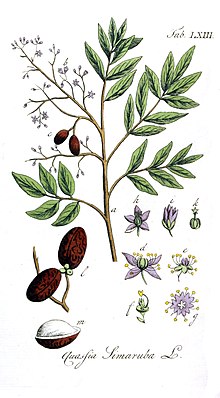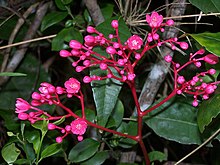
Apiaceae or Umbelliferae is a family of mostly aromatic flowering plants named after the type genus Apium, and commonly known as the celery, carrot or parsley family, or simply as umbellifers. It is the 16th-largest family of flowering plants, with more than 3,800 species in about 446 genera, including such well-known, and economically important plants as ajwain, angelica, anise, asafoetida, caraway, carrot, celery, chervil, coriander, cumin, dill, fennel, lovage, cow parsley, parsley, parsnip and sea holly, as well as silphium, a plant whose exact identity is unclear and may be extinct.

Quassia is a plant genus in the family Simaroubaceae. Its size is disputed; some botanists treat it as consisting of only one species, Quassia amara from tropical South America, while others treat it in a wide circumscription as a pantropical genus containing up to 40 species of trees and shrubs.

Sapindales is an order of flowering plants. Well-known members of Sapindales include citrus; maples, horse-chestnuts, lychees and rambutans; mangos and cashews; frankincense and myrrh; mahogany and neem.

The Rutaceae is a family, commonly known as the rue or citrus family, of flowering plants, usually placed in the order Sapindales.

Geraniales is a small order of flowering plants, included within the rosid subclade of eudicots. The largest family in the order is Geraniaceae with over 800 species. In addition, the order includes the smaller Francoaceae with about 40 species. Most Geraniales are herbaceous, but there are also shrubs and small trees.

Acorus is a genus of monocot flowering plants. This genus was once placed within the family Araceae (aroids), but more recent classifications place it in its own family Acoraceae and order Acorales, of which it is the sole genus of the oldest surviving line of monocots. Some older studies indicated that it was placed in a lineage, that also includes aroids (Araceae), Tofieldiaceae, and several families of aquatic monocots. However, modern phylogenetic studies demonstrate that Acorus is sister to all other monocots. Common names include calamus and sweet flag.
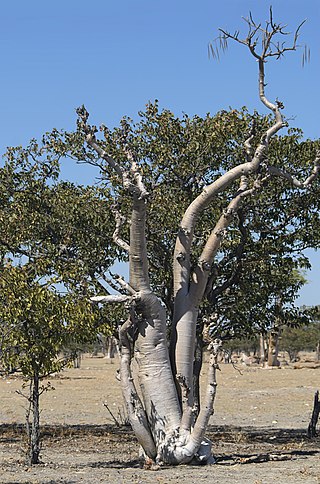
Moringa is the sole genus in the plant family Moringaceae. It contains 13 species, which occur in tropical and subtropical regions of Africa and Asia and that range in size from tiny herbs to massive trees. Moringa species grow quickly in many types of environments.
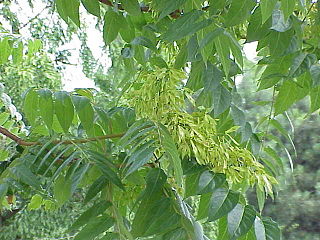
The Simaroubaceae, also known as the quassia family, are a small, mostly tropical, family in the order Sapindales. In recent decades, it has been subject to much taxonomic debate, with several small families being split off. A molecular phylogeny of the family was published in 2007, greatly clarifying relationships within the family. Together with chemical characteristics such as the occurrence of petroselinic acid in Picrasma, in contrast to other members of the family such as Ailanthus, this indicates the existence of a subgroup in the family with Picrasma, Holacantha, and Castela.

The Burseraceae are a moderate-sized family of 17-19 genera and about 540 species of woody flowering plants. The actual numbers given in taxonomic sources differ according to taxonomic revision at the time of writing. The Burseraceae are also known as the torchwood family, the frankincense and myrrh family, or simply the incense tree family. The family includes both trees and shrubs; its species are native to tropical regions of Africa, Asia, Australasia, and the Americas.

Quassia amara, also known as amargo, bitter-ash, bitter-wood, or hombre grande is a species in the genus Quassia, with some botanists treating it as the sole species in the genus. The genus was named by Carl Linnaeus who named it after the first botanist to describe it: the Surinamese freedman Graman Quassi. Q. amara is used as insecticide, in traditional medicine and as additive in the food industry.

Theophrastoideae is a small subfamily of flowering plants in the family Primulaceae. It was formerly recognized as a separate family Theophrastaceae. As previously circumscribed, the family consisted of eight genera and 95 species of trees or shrubs, native to tropical regions of the Americas.
Pierreodendron is a genus of plants in the family Simaroubaceae.
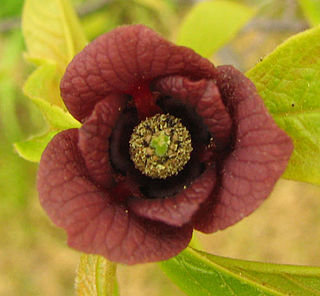
Magnoliids, Magnoliidae or Magnolianae are a clade of flowering plants. With more than 10,000 species, including magnolias, nutmeg, bay laurel, cinnamon, avocado, black pepper, tulip tree and many others, it is the third-largest group of angiosperms after the eudicots and monocots. The group is characterized by trimerous flowers, pollen with one pore, and usually branching-veined leaves.

Simarouba glauca is a flowering tree that is native to Florida, South America, and the Caribbean. Common names include paradise-tree, dysentery-bark, and bitterwood. The tree is well suited for warm, humid, tropical regions. Its cultivation depends on rainfall distribution, water holding capacity of the soil, and sub-soil moisture. It is suited for temperature range of 10 to 40 °C, and can grow at elevations from sea level to 1,000 m (3,300 ft). It grows 40 to 50 ft tall and has a span of 25 to 30 ft. It bears yellow flowers and purple elongated oval fleshy fruits.

Simarouba amara is a species of tree in the family Simaroubaceae, found in the rainforests and savannahs of South and Central America and the Caribbean. It was first described by Aubl. in French Guiana in 1775 and is one of six species of Simarouba. The tree is evergreen, but produces a new set of leaves once a year. It requires relatively high levels of light to grow and grows rapidly in these conditions, but lives for a relatively short time. In Panama, it flowers during the dry season in February and March, whereas in Costa Rica, where there is no dry season it flowers later, between March and July. As the species is dioecious, the trees are either male or female and only produce male or female flowers. The small yellow flowers are thought to be pollinated by insects, the resulting fruits are dispersed by animals including monkeys, birds and fruit-eating bats and the seeds are also dispersed by leaf cutter ants.

Quassinoids are degraded triterpene lactones of the Simaroubaceae plant family grouped into C-18, C-19, C-20, C-22 and C-25 types. The prototypical member of the group, quassin, was first described in the 19th century from plants of the genus Quassia from which it gets its name. It was isolated in 1937, and its structure elucidated in 1961.
Bitter wood is a common name for several trees, all from the family Simaroubaceae, and may refer to:
Samadera harmandiana is a freshwater mangrove shrub or small tree in the Simaroubaceae family. It is found in Cambodia, Laos and Vietnam. The wood provides firewood. Certain fish eat the poisonous fruit

Samadera is a genus of four species of plants belonging to the family Simaroubaceae in the order Sapindales. Its range is from eastern Africa through tropical Asia to eastern Australia.

Samadera indica, the bitter wood or Niepa bark tree, is a species of plant in the family Simaroubaceae. It is a shrub or tree and grows primarily in wet tropical regions, from west Africa, through India, then down through Indonesia to Malesia.
